Contents
�
1: Python Basics
b'Chapter 1: Python Basics'
b'Python installation'
b'Variable assignment, empty space, and writing our own programs'
b'Writing a Python function'
b'Python loops'
b'Data input'
b'Data manipulation'
b'Data output'
b'Exercises'
b'Summary'
2: Introduction to Python Modules
b'Chapter 2: Introduction to Python Modules'
b'What is a Python module?'
b'Introduction to NumPy'
b'Introduction to SciPy'
b'Introduction to matplotlib'
b'Introduction to statsmodels'
b'Introduction to pandas'
b'Python modules related to finance'
b'Introduction to the pandas_reader module'
b'Two financial calculators'
b'How to install a Python module'
b'Module dependency'
b'Exercises'
b'Summary'
3: Time Value of Money
b'Chapter 3: Time Value of Money'
b'Introduction to time value of money'
b'Writing a financial calculator in Python'
b'Definition of NPV and NPV rule'
b'Definition of IRR and IRR rule'
b'Definition of payback period and payback period rule'
b'Writing your own financial calculator in Python'
b'Two general formulae for many functions'
b'Exercises'
b'Summary'
�
4: Sources of Data
b'Chapter 4: Sources of Data'
b'Diving into deeper concepts'
5: Bond and Stock Valuation
b'Chapter 5: Bond and Stock Valuation'
b'Introduction to interest rates'
b'Term structure of interest rates'
b'Bond evaluation'
b'Stock valuation'
b'A new data type \xe2\x80\x93 dictionary'
b'Summary'
6: Capital Asset Pricing Model
b'Chapter 6: Capital Asset Pricing Model'
b'Introduction to CAPM'
b'Moving beta'
b'Adjusted beta'
b'Extracting output data'
b'Simple string manipulation'
b'Python via Canopy'
b'References'
b'Exercises'
b'Summary'
7: Multifactor Models and Performance Measures
b'Chapter 7: Multifactor Models and Performance Measures'
b'Introduction to the Fama-French three-factor model'
b'Fama-French three-factor model'
b'Fama-French-Carhart four-factor model and Fama-French five-
factor model'
b'Implementation of Dimson (1979) adjustment for beta'
b'Performance measures'
b'How to merge different datasets'
b'References'
b'Exercises'
b'Summary'
8: Time-Series Analysis
b'Chapter 8: Time-Series Analysis'
b'Introduction to time-series analysis'
�
b'Merging datasets based on a date variable'
b'Understanding the interpolation technique'
b'Tests of normality'
b'52-week high and low trading strategy'
b'Estimating Roll's spread'
b'Estimating Amihud's illiquidity'
b'Estimating Pastor and Stambaugh (2003) liquidity measure'
b'Fama-MacBeth regression'
b'Durbin-Watson'
b'Python for high-frequency data'
b'Spread estimated based on high-frequency data'
b'Introduction to CRSP'
b'References'
b'Exercises'
b'Summary'
9: Portfolio Theory
b'Chapter 9: Portfolio Theory'
b'Introduction to portfolio theory'
b'A 2-stock portfolio'
b'Optimization \xe2\x80\x93 minimization'
b'Forming an n-stock portfolio'
b'Constructing an optimal portfolio'
b'Constructing an efficient frontier with n stocks'
b'References'
b'Exercises'
b'Summary'
10: Options and Futures
b'Chapter 10: Options and Futures'
b'Introducing futures'
b'Payoff and profit/loss functions for call and put options'
b'European versus American options'
b'Black-Scholes-Merton option model on non-dividend paying
stocks'
b'Generating our own module p4f'
b'European options with known dividends'
b'Various trading strategies'
b'Put-call parity and its graphic presentation'
�
b'Chapter 11: Value at Risk'
b'Introduction to VaR'
b'Normality tests'
b'Skewness and kurtosis'
b'Modified VaR'
b'VaR based on sorted historical returns'
b'Simulation and VaR'
b'VaR for portfolios'
b'Backtesting and stress testing'
b'Expected shortfall'
b'References'
b'Exercises'
b'Summary'
12: Monte Carlo Simulation
b'Binomial tree and its graphic presentation'
b'Hedging strategies'
b'Implied volatility'
b'Binary-search'
b'Retrieving option data from Yahoo! Finance'
b'Volatility smile and skewness'
b'References'
b'Exercises'
b'Summary'
11: Value at Risk
b'Chapter 12: Monte Carlo Simulation'
b'Importance of Monte Carlo Simulation'
b'Generating random numbers from a standard normal distribution'
b'Generating random numbers with a seed'
b'Generating random numbers from a uniform distribution'
b'Using simulation to estimate the pi value'
b'Generating random numbers from a Poisson distribution'
b'Selecting m stocks randomly from n given stocks'
b'With/without replacements'
b'Distribution of annual returns'
b'Simulation of stock price movements'
b'Graphical presentation of stock prices at options' maturity dates'
b'Replicating a Black-Scholes-Merton call using simulation'
�
b'Liking two methods for VaR using simulation'
b'Capital budgeting with Monte Carlo Simulation'
b'Python SimPy module'
b'Comparison between two social policies \xe2\x80\x93 basic
income and basic job'
b'Finding an efficient frontier based on two stocks by using
simulation'
b'Constructing an efficient frontier with n stocks'
b'Long-term return forecasting'
b'Efficiency, Quasi-Monte Carlo, and Sobol sequences'
b'References'
b'Exercises'
b'Summary'
13: Credit Risk Analysis
b'Chapter 13: Credit Risk Analysis'
b'Introduction to credit risk analysis'
b'Credit rating'
b'Credit spread'
b'YIELD of AAA-rated bond, Altman Z-score'
b'Using the KMV model to estimate the market value of total assets
and its volatility'
b'Term structure of interest rate'
b'Distance to default'
b'Credit default swap'
b'References'
b'Exercises'
b'Summary'
14: Exotic Options
b'Chapter 14: Exotic Options'
b'European, American, and Bermuda options'
b'Chooser options'
b'Shout options'
b'Binary options'
b'Rainbow options'
b'Pricing average options'
b'Pricing barrier options'
b'Barrier in-and-out parity'
�
b'Graph of up-and-out and up-and-in parity'
b'Pricing lookback options with floating strikes'
b'References'
b'Exercises'
b'Summary'
15: Volatility, Implied Volatility, ARCH, and GARCH
b'Chapter 15: Volatility, Implied Volatility, ARCH, and GARCH'
b'Conventional volatility measure \xe2\x80\x93 standard deviation'
b'Tests of normality'
b'Estimating fat tails'
b'Lower partial standard deviation and Sortino ratio'
b'Test of equivalency of volatility over two periods'
b'Test of heteroskedasticity, Breusch, and Pagan'
b'Volatility smile and skewness'
b'Graphical presentation of volatility clustering'
b'The ARCH model'
b'Simulating an ARCH (1) process'
b'The GARCH model'
b'Simulating a GARCH process'
b'Simulating a GARCH (p,q) process using modified garchSim()'
b'GJR_GARCH by Glosten, Jagannanthan, and Runkle'
b'References'
b'Exercises'
b'Summary'
backindex: Appendix A: Index
b'Chapter Appendix A: Index'
�
Chapter 1. Python Basics
In this chapter, we will discuss basic concepts and several widely used
functions related to Python. This chapter plus the next one (Chapter 2,
Introduction to Python Modules) are only the chapters exclusively based on
Python techniques. Those two chapters serve as a review for readers who
have some basic Python knowledge. There is no way that a beginner, with no
prior Python knowledge, could master Python by reading just those two
chapters. For a new learner who wants to learn Python in more detail, he/she
could find many good books. From Chapter 3, Time Value of Money onward,
we will use Python, which will help in explaining or demonstrating various
finance concepts, running regression, and processing data related to
economics, finance, and accounting. Because of this, we will offer more
Python-related techniques and usages in each of the upcoming chapters.
In particular, in this chapter, we will discuss the following topics:
Python installation
Variable assignment, empty space, and writing our own programs
Writing a Python function
Data input
Data manipulation
Data output
�
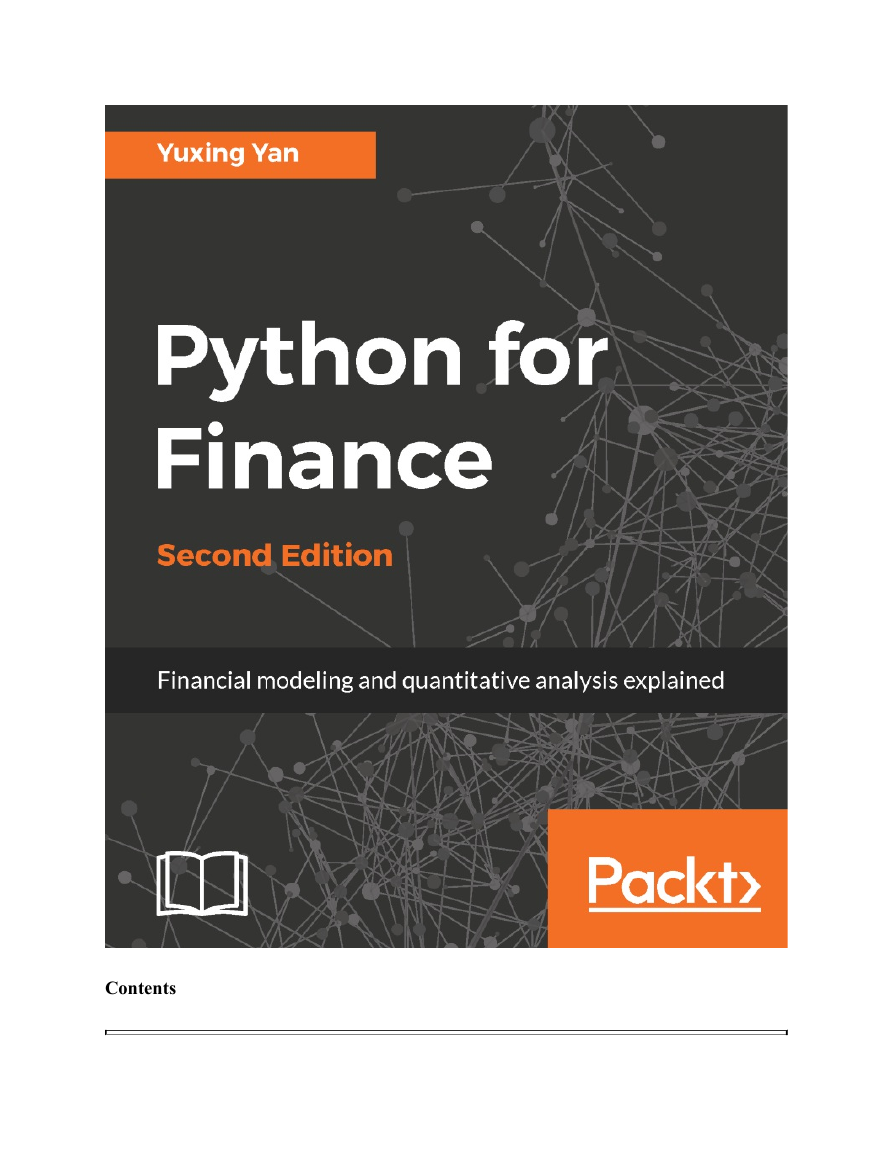
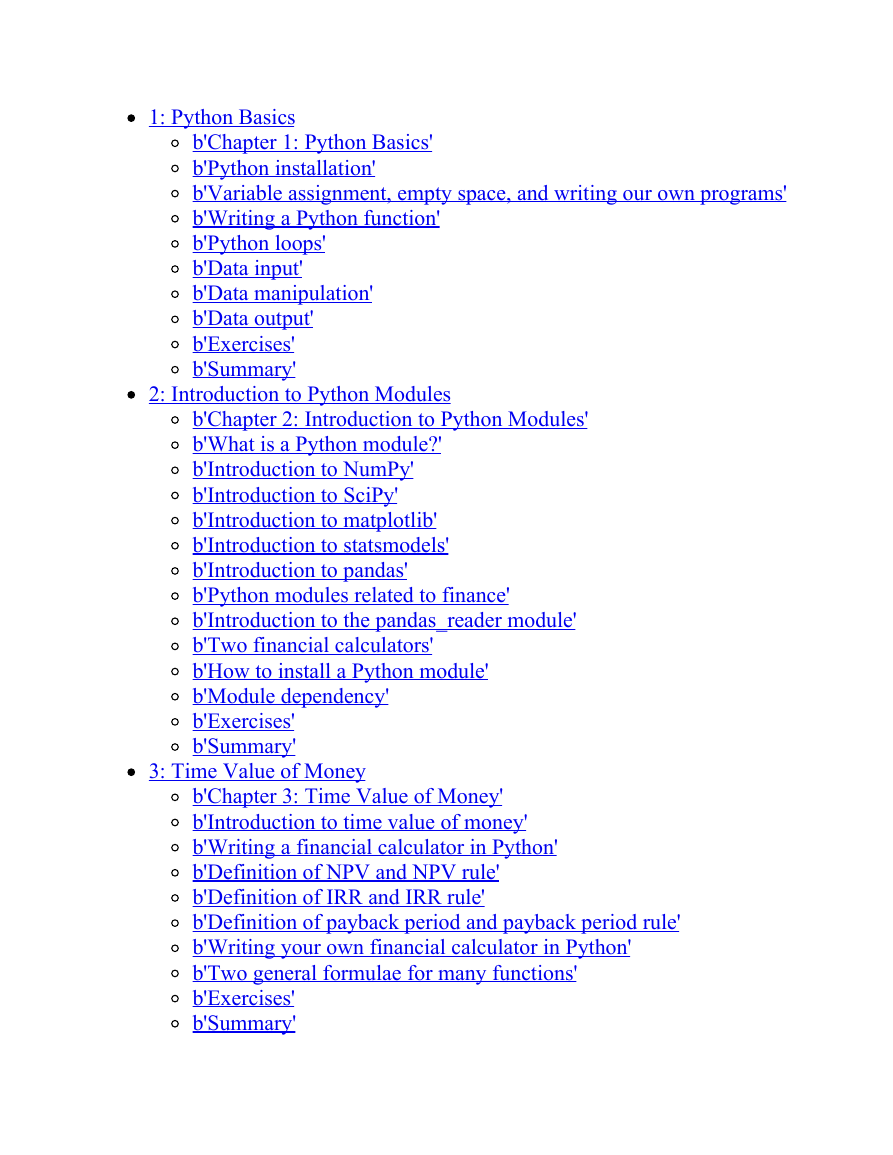
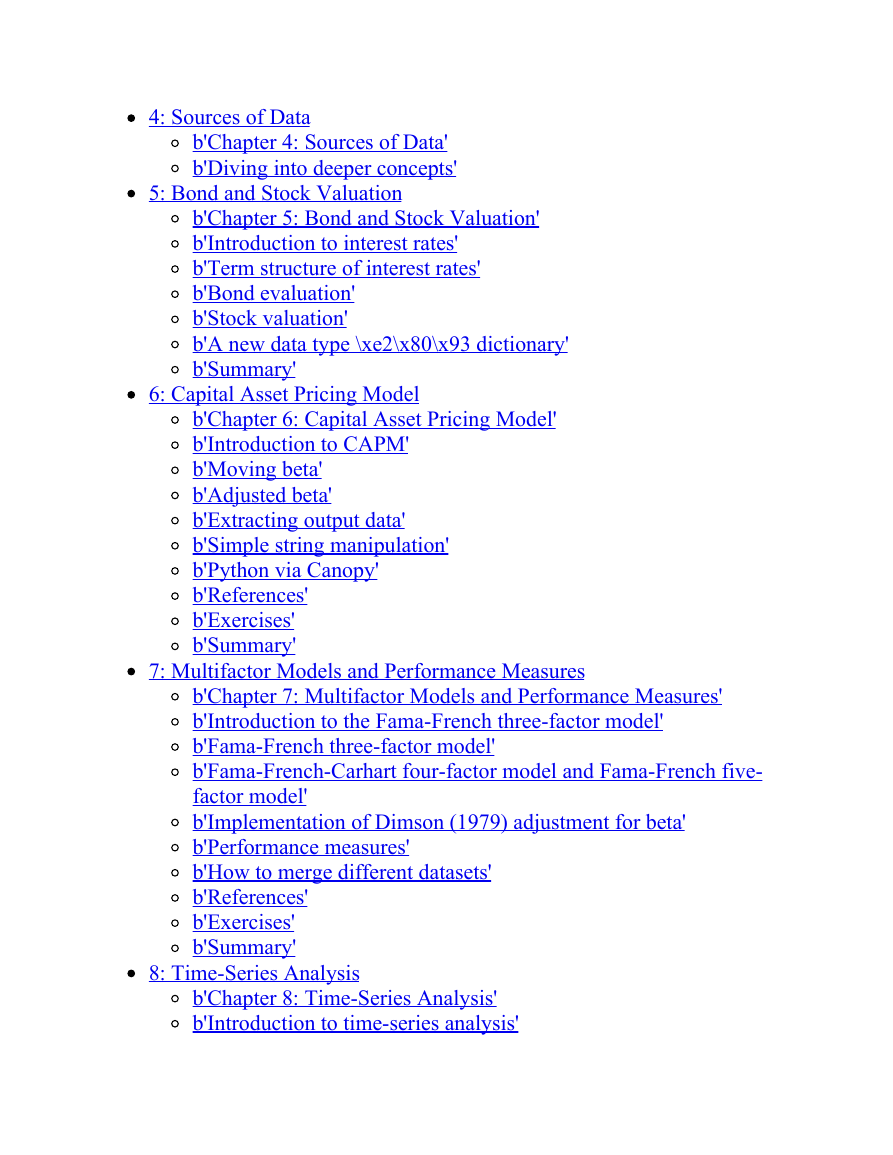
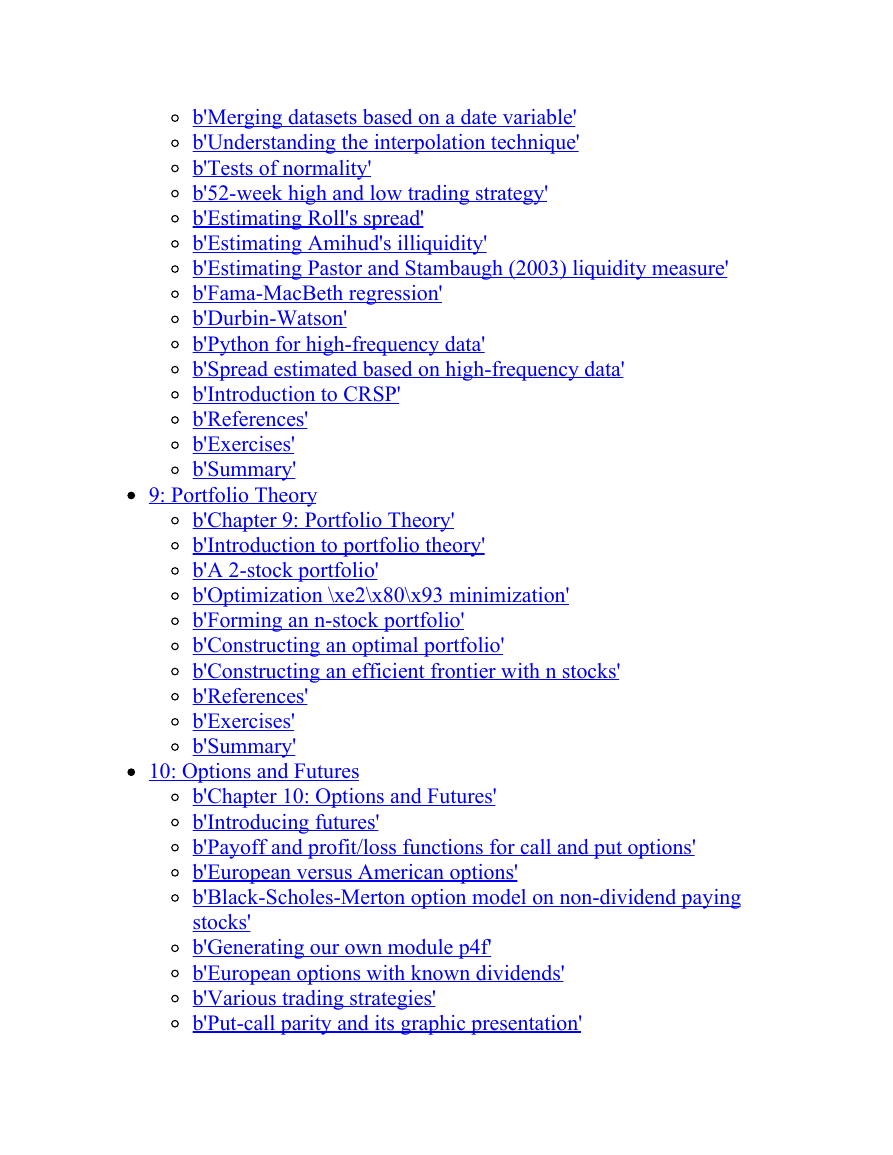
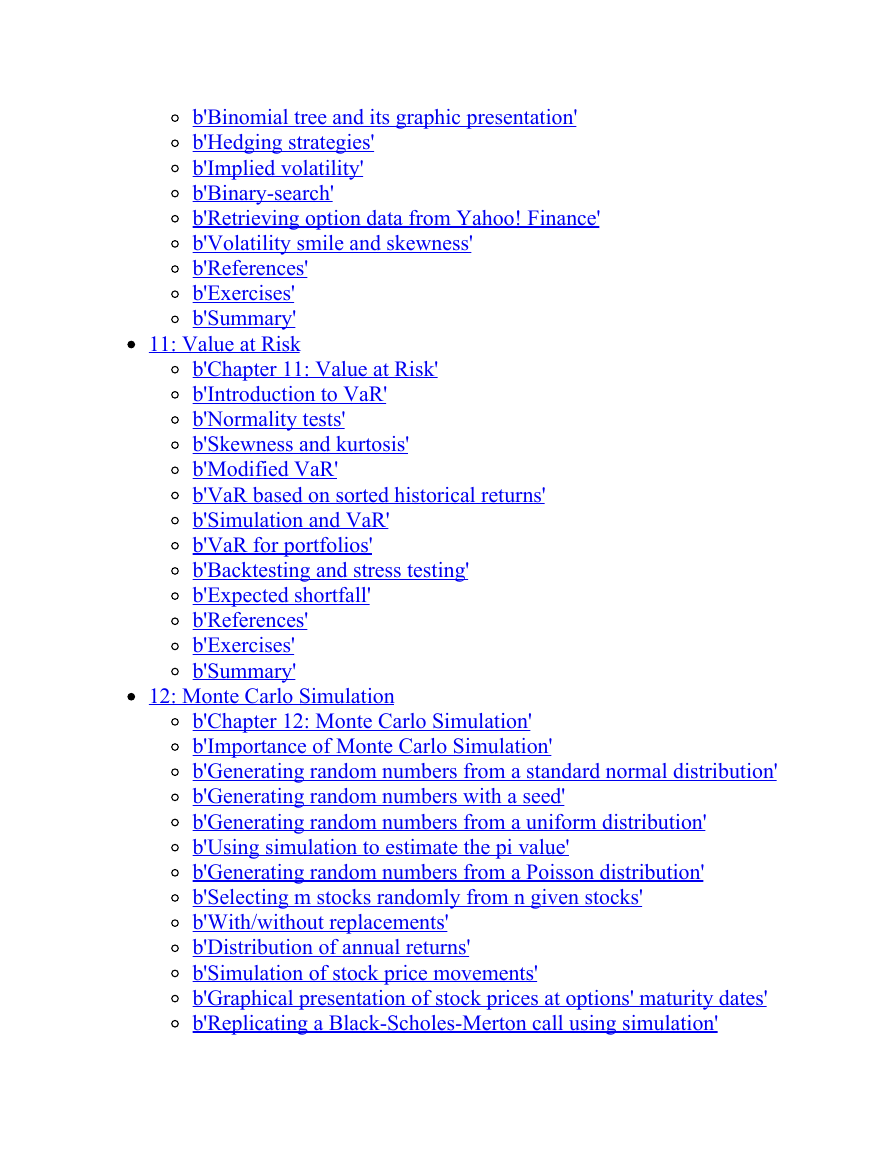
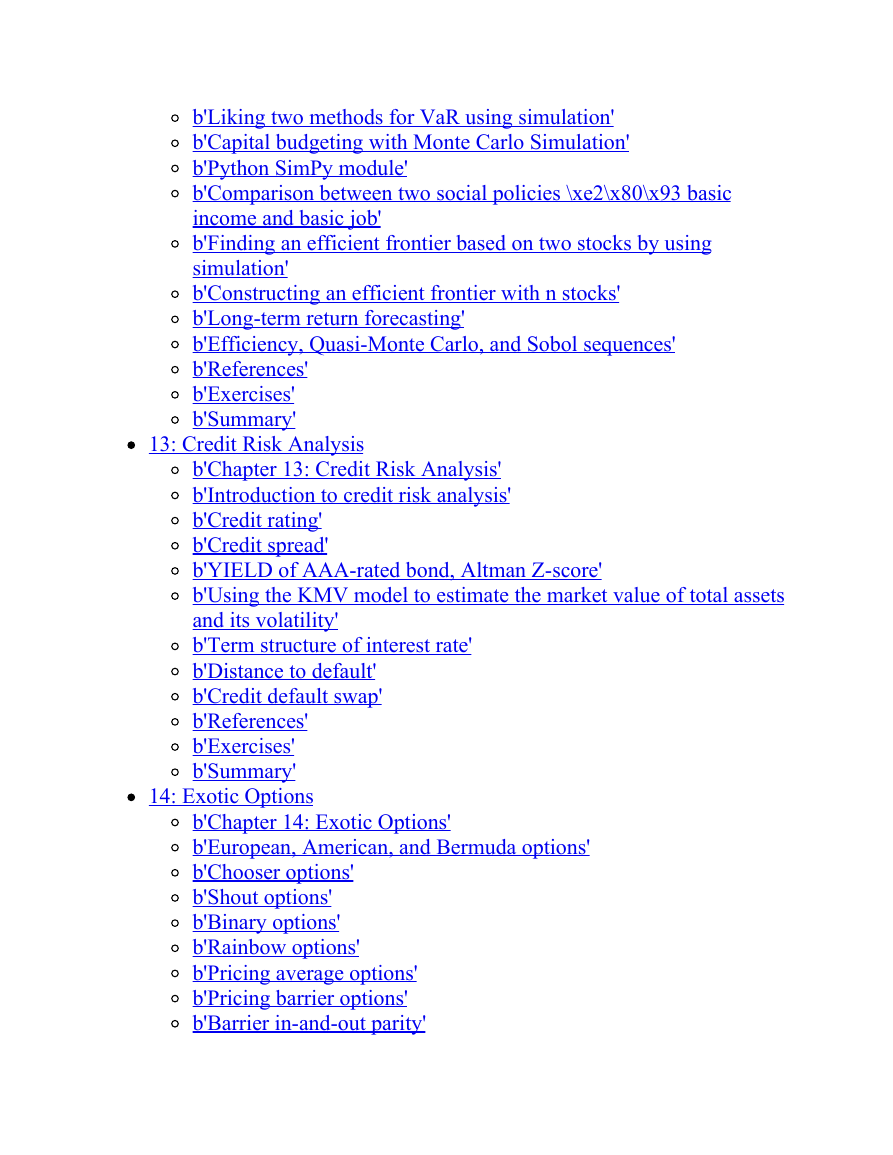

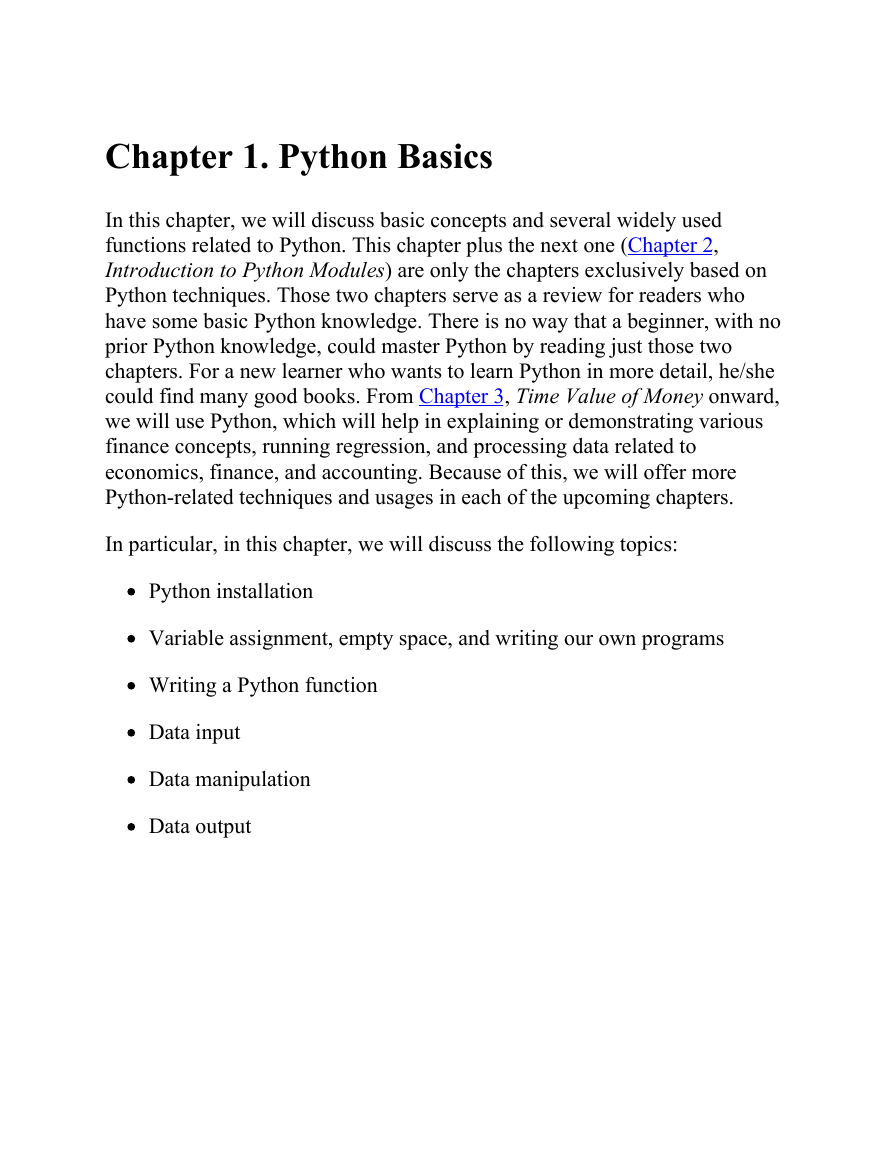








 2023年江西萍乡中考道德与法治真题及答案.doc
2023年江西萍乡中考道德与法治真题及答案.doc 2012年重庆南川中考生物真题及答案.doc
2012年重庆南川中考生物真题及答案.doc 2013年江西师范大学地理学综合及文艺理论基础考研真题.doc
2013年江西师范大学地理学综合及文艺理论基础考研真题.doc 2020年四川甘孜小升初语文真题及答案I卷.doc
2020年四川甘孜小升初语文真题及答案I卷.doc 2020年注册岩土工程师专业基础考试真题及答案.doc
2020年注册岩土工程师专业基础考试真题及答案.doc 2023-2024学年福建省厦门市九年级上学期数学月考试题及答案.doc
2023-2024学年福建省厦门市九年级上学期数学月考试题及答案.doc 2021-2022学年辽宁省沈阳市大东区九年级上学期语文期末试题及答案.doc
2021-2022学年辽宁省沈阳市大东区九年级上学期语文期末试题及答案.doc 2022-2023学年北京东城区初三第一学期物理期末试卷及答案.doc
2022-2023学年北京东城区初三第一学期物理期末试卷及答案.doc 2018上半年江西教师资格初中地理学科知识与教学能力真题及答案.doc
2018上半年江西教师资格初中地理学科知识与教学能力真题及答案.doc 2012年河北国家公务员申论考试真题及答案-省级.doc
2012年河北国家公务员申论考试真题及答案-省级.doc 2020-2021学年江苏省扬州市江都区邵樊片九年级上学期数学第一次质量检测试题及答案.doc
2020-2021学年江苏省扬州市江都区邵樊片九年级上学期数学第一次质量检测试题及答案.doc 2022下半年黑龙江教师资格证中学综合素质真题及答案.doc
2022下半年黑龙江教师资格证中学综合素质真题及答案.doc